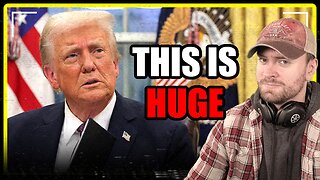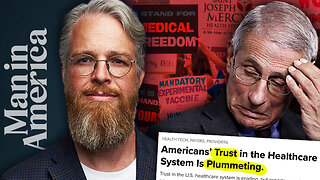Premium Only Content

Are We Facing a 1920s-Like Economic Collapse?
Roaring Twenties vs. Today: Are We on the Brink of a 1920s-Style Economic Disaster?
Today, we’re tackling a hot topic that’s been on everyone’s mind—could we be on the brink of a 1920s-style economic disaster? The Roaring Twenties were a time of extraordinary prosperity, but they ended with the catastrophic stock market crash of 1929. As we look at today’s economy, many are asking if we’re seeing signs of a similar crisis. Let’s dive into the similarities and warning signs that could suggest history might be repeating itself."
Roaring Twenties vs. Today
"In the 1920s, the U.S. was in the midst of a roaring economic boom. The aftermath of World War I set the stage for rapid technological advancements and unprecedented industrial growth. Innovations such as the automobile and the radio revolutionized daily life. The stock market was on fire, with people pouring money into stocks and borrowing heavily to invest."
"Fast forward to today, and we’re seeing some eerily familiar patterns. The recovery from the 2008 financial crisis has spurred massive technological progress, from smartphones to artificial intelligence. We’ve seen substantial growth in the stock market and consumer spending. But this rapid expansion is raising concerns that history might be on repeat."
1920s Economic Crash
"One major red flag in the 1920s was overleveraging. Investors were buying stocks on margin, borrowing money to bet on stock prices rising. This made them extremely vulnerable to market swings. When the market finally crashed in 1929, many were left with massive debts and worthless stocks."
"Today, we see a similar story. With easy credit available, both individuals and corporations are borrowing extensively. There’s been a surge in speculative investments, particularly in high-tech startups and cryptocurrencies. This raises concerns about potential bubbles that could burst, leading to a new financial crisis."
"Income inequality was another significant issue in the 1920s. The rich were getting richer while the average worker saw little benefit from the booming economy. This growing disparity contributed to the economic instability that led to the Great Depression."
"Fast forward to today, and income inequality remains a critical issue. Despite overall economic growth, wealth is increasingly concentrated among the top 1% while many people struggle with stagnant wages and rising costs. This uneven distribution of wealth is creating social and economic tensions that echo the pre-Depression era."
"The late 1920s were marked by extreme market volatility. As stock prices soared to unsustainable levels, panic selling took hold, culminating in the devastating crash of October 1929. We’re seeing similar volatility today, driven by global events like trade wars, geopolitical tensions, and the ongoing effects of the COVID-19 pandemic."
"While the similarities are striking, there are key differences today. Modern financial systems have advanced significantly, with stronger regulatory frameworks and more proactive central bank interventions. For instance, the Federal Reserve now plays a more active role in managing economic stability and preventing crises."
"Understanding these parallels helps us better prepare for potential economic challenges. By learning from the past and addressing critical issues such as overleveraging, income inequality, and market speculation, we can take steps towards a more resilient financial future."
"So, are we heading for a 1920s-style economic crash? While there are significant similarities between then and now, the differences in today’s financial landscape also play a crucial role. Staying informed, proactive, and vigilant is essential to navigating potential risks.
Thanks for watching! If you found this video insightful, don’t forget to like, share, and subscribe for more updates and in-depth analysis on the economy!"
-
 2:08:25
2:08:25
Side Scrollers Podcast
17 hours agoEXCLUSIVE: Marty O’Donnell BREAKS SILENCE On Bungie Drama + Kotaku Hypocrisy + MORE | Side Scrollers
3.24K1 -
 2:31:49
2:31:49
MattMorseTV
17 hours ago $0.18 earned🔴Trump's Oval Office BOMBSHELL.🔴
10.6K41 -
 25:14
25:14
GritsGG
13 hours agoRank 1 Player Spectates Casual Solos!
2.39K -
 LIVE
LIVE
Lofi Girl
2 years agoSynthwave Radio 🌌 - beats to chill/game to
1,374 watching -
 4:33:40
4:33:40
FreshandFit
7 hours agoAfter Hours w/ Girls
219K95 -
 2:33:36
2:33:36
Badlands Media
8 hours agoOnlyLands Ep. 21: From Trump’s VP Pick to Green Energy Grift
57.7K6 -
 1:07:26
1:07:26
Inverted World Live
11 hours agoThe War Against Robots w/ Joe Allen
90.9K5 -
 6:08:31
6:08:31
SpartakusLIVE
11 hours agoWARZONE NUKE IS BACK?! || Solo Challenge CHAMPION to start, duos w/ the Dawg later
92.1K1 -
 1:00:18
1:00:18
Man in America
12 hours agoBig Pharma’s Empire of Lies Is COLLAPSING as People Turn to Natural Medicine
56K20 -

Drew Hernandez
14 hours agoGHISLAINE MAXWELL SAYS CLAIMS EPSTEIN WAS INTELLIGENCE ASSET ARE BULLSH*T?!
31.4K12